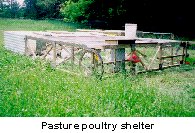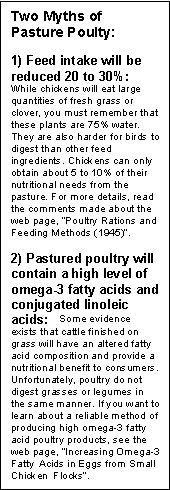Pastured Poultry
PDF Version (26KB)

Pasture poultry is an intensive method of raising a large number of chickens on a small piece of land. Under this system, birds are housed in mobile shelters with roofs and side walls but no floors; the birds sit on the grass under the shelters. Because chickens do not herd as easily as geese or turkeys, the shelters provide an easy means of corralling the birds and moving them from one spot to another in the pasture. By moving the shelters daily to a fresh patch of grass, the grass is not trampled by the birds and stays in better condition than under traditional range rearing. More chickens can be kept per acre because the grass stays fresher and may remain as a soft bedding even when a large number of birds are raised in a field. When properly managed, 1,000 chickens can be raised in shelters on one acre of pasture compared to 250 birds under free range management.
One of the keys to proper management is to never put the birds out on pasture before six weeks of age; you must wait until the birds are fully feathered and no longer need supplemental heat. In years past it was common to start day-old chicks in range shelters with coal or oil stoves but the pasture poultry shelters used today do not have stoves and birds should not be moved into them until the brooding period is completed. Modern meat-type chickens are especially susceptible to chilling and chilling has caused mortality as high as 80% in some small flocks in Manitoba. Chilling early in life can elevate mortality throughout the life of the flock. To keep the birds comfortable before moving them out to pasture, you also need to provide at least 0.1 m2 (1 ft.2) of floor space per bird up to six weeks of age.
Once the chickens are in the pasture shelters, it is recommended that you provide 0.15 m2 (1.5 ft.2) of floor space per small broiler (1.8 kg or 4 lb. live weight) or 0.2 m2 (2 ft.2) per roaster (2.7 kg or 6 lb. live weight). Remember that meat-type chickens today reach heavier weights at younger ages than in the past and recommended densities are lower than with old-fashioned breeds. This space requirement is particularly necessary during periods of heat stress. Because you are confining the birds to a shelter with no fans or other reliable ventilation, you must give the birds room to spread out and help stop heat from building up in the shelter. You should be able to remove any solid walls or cloths covering the sides of the shelters on hot days; you want as much breeze as possible to flow over the birds. Remember that the birds are confined to a small area and you must provide them the conditions that they need to be comfortable.
If the shelters are moved frequently and precipitation is adequate, the pasture will provide soft bedding for the birds. Because properly managed pasture is less abrasive, chickens raised on pasture may have a lower incidence of breast blisters. Moving the shelter regularly will reduce the number of droppings that the chickens eat and lower the chances that they will become infected with coccidiosis (the most common type of intestinal parasite in chickens). Since coccidia can survive eight weeks in a field, it is important to never return the birds to the same spot in the pasture in the same year. Other intestinal parasites can survive more than a year in a field and so you should never have chickens on the same field two years in a row.

Related Articles::

